IrrMapper: A Machine Learning Approach for High Resolution Mapping of Irrigated Agriculture Across the Western U.S.
Abstract
:1. Introduction
2. Data and Methods
2.1. Methodological Overview
2.2. Study Area
2.3. Landsat and Aerial Imagery
2.4. Meteorology and Climate Data
2.5. Terrain and Land Use Data
2.6. Training Data
2.7. Model Training and Classification
2.8. Model Cross Validation
2.9. Comparison with National Agricultural Statistics Service Data
2.10. Calculation of Irrigated Area Change
3. Results
3.1. Model Accuracy
3.2. Variable Importance
3.3. Comparison with NASS Data
3.4. Trends in Irrigation
4. Discussion
5. Conclusions
Supplementary Materials
Author Contributions
Funding
Acknowledgments
Conflicts of Interest
References
- Dieter, C.A. Water Availability and Use Science Program: Estimated Use of Water in the United States in 2015; U.S. Geological Survey: Reston, VA, USA, 2018. [Google Scholar]
- United States Department of Agriculture, National Agricultural Statistics. Quick Stats. 2017. Available online: https://data.nal.usda.gov/dataset/nass-quick-stats (accessed on 20 March 2019).
- Li, X.; Troy, T. Changes in rainfed and irrigated crop yield response to climate in the western US. Environ. Res. Lett. 2018, 13, 064031. [Google Scholar] [CrossRef]
- Wurster, P.; Maneta, M.; Beguería, S.; Cobourn, K.; Maxwell, B.; Silverman, N.; Ewing, S.; Jensco, K.; Gardner, P.; Kimball, J.; et al. Characterizing the impact of climatic and price anomalies on agrosystems in the northwest United States. Agric. For. Meteorol. 2020, 280, 107778. [Google Scholar] [CrossRef]
- Troy, T.J.; Kipgen, C.; Pal, I. The impact of climate extremes and irrigation on US crop yields. Environ. Res. Lett. 2015, 10, 054013. [Google Scholar] [CrossRef] [Green Version]
- Schauberger, B.; Archontoulis, S.; Arneth, A.; Balkovic, J.; Ciais, P.; Deryng, D.; Elliott, J.; Folberth, C.; Khabarov, N.; Müller, C.; et al. Consistent negative response of US crops to high temperatures in observations and crop models. Nat. Commun. 2017, 8, 1–9. [Google Scholar] [CrossRef] [Green Version]
- Sacks, W.J.; Cook, B.I.; Buenning, N.; Levis, S.; Helkowski, J.H. Effects of global irrigation on the near-surface climate. Clim. Dyn. 2009, 33, 159–175. [Google Scholar] [CrossRef] [Green Version]
- Yang, B.; Zhang, Y.; Qian, Y.; Tang, J.; Liu, D. Climatic effects of irrigation over the Huang-Huai-Hai Plain in China simulated by the weather research and forecasting model. J. Geophys. Res. Atmos. 2016, 121, 2246–2264. [Google Scholar] [CrossRef] [Green Version]
- Yang, Z.; Dominguez, F.; Zeng, X.; Hu, H.; Gupta, H.; Yang, B. Impact of irrigation over the California Central Valley on regional climate. J. Hydrometeorol. 2017, 18, 1341–1357. [Google Scholar] [CrossRef] [Green Version]
- Yang, Z.; Qian, Y.; Liu, Y.; Berg, L.K.; Hu, H.; Dominguez, F.; Yang, B.; Feng, Z.; Gustafson, W.I., Jr.; Huang, M.; et al. Irrigation Impact on Water and Energy Cycle During Dry Years Over the United States Using Convection-Permitting WRF and a Dynamical Recycling Model. J. Geophys. Res. Atmos. 2019, 124, 11220–11241. [Google Scholar] [CrossRef]
- Sterling, S.M.; Ducharne, A.; Polcher, J. The impact of global land-cover change on the terrestrial water cycle. Nat. Clim. Change 2013, 3, 385–390. [Google Scholar] [CrossRef]
- Reisner, M. Cadillac Desert: The American West and Its Disappearing Water; Penguin Books: London, UK, 1993. [Google Scholar]
- Peck, D.E.; Lovvorn, J.R. The importance of flood irrigation in water supply to wetlands in the Laramie Basin, Wyoming, USA. Wetlands 2001, 21, 370–378. [Google Scholar] [CrossRef]
- Stanley, D.J.; Warne, A.G. Nile Delta: Recent geological evolution and human impact. Science 1993, 260, 628–634. [Google Scholar] [CrossRef] [PubMed]
- Pitman, M.G.; Läuchli, A. Global impact of salinity and agricultural ecosystems. In Salinity: Environment-Plants-Molecules; Springer: Berlin/Heidelberg, Germany, 2002; pp. 3–20. [Google Scholar]
- Essaid, H.I.; Caldwell, R.R. Evaluating the impact of irrigation on surface water–groundwater interaction and stream temperature in an agricultural watershed. Sci. Total. Environ. 2017, 599, 581–596. [Google Scholar] [CrossRef] [PubMed]
- Haacker, E.M.; Kendall, A.D.; Hyndman, D.W. Water level declines in the High Plains Aquifer: Predevelopment to resource senescence. Groundwater 2016, 54, 231–242. [Google Scholar] [CrossRef] [PubMed]
- Ritzema, H.; Satyanarayana, T.; Raman, S.; Boonstra, J. Subsurface drainage to combat waterlogging and salinity in irrigated lands in India: Lessons learned in farmers’ fields. Agric. Water Manag. 2008, 95, 179–189. [Google Scholar] [CrossRef]
- Scanlon, B.R.; Jolly, I.; Sophocleous, M.; Zhang, L. Global impacts of conversions from natural to agricultural ecosystems on water resources: Quantity versus quality. Water Resour. Res. 2007, 43. [Google Scholar] [CrossRef] [Green Version]
- Skaggs, R.W.; Breve, M.; Gilliam, J. Hydrologic and water quality impacts of agricultural drainage. Crit. Rev. Environ. Sci. Technol. 1994, 24, 1–32. [Google Scholar] [CrossRef]
- Kendy, E.; Bredehoeft, J.D. Transient effects of groundwater pumping and surface-water-irrigation returns on streamflow. Water Resour. Res. 2006, 42. [Google Scholar] [CrossRef]
- United States Department of Agriculture, National Agricultural Statistics Service. Census of Agriculture; National Agricultural Statistics Service: Washington, DC, USA, 2007; Volume 1.
- Young, L.J.; Lamas, A.C.; Abreu, D.A. The 2012 Census of Agriculture: A capture–recapture analysis. J. Agric. Biol. Environ. Stat. 2017, 22, 523–539. [Google Scholar] [CrossRef]
- Exbrayat, J.F.; Bloom, A.A.; Carvalhais, N.; Fischer, R.; Huth, A.; MacBean, N.; Williams, M. Understanding the land carbon cycle with space data: Current status and prospects. Surv. Geophys. 2019, 40, 735–755. [Google Scholar] [CrossRef] [Green Version]
- Sheffield, J.; Wood, E.F.; Pan, M.; Beck, H.; Coccia, G.; Serrat-Capdevila, A.; Verbist, K. Satellite Remote Sensing for Water Resources Management: Potential for Supporting Sustainable Development in Data-Poor Regions. Water Resour. Res. 2018, 54, 9724–9758. [Google Scholar] [CrossRef] [Green Version]
- Pettorelli, N.; Schulte to Bühne, H.; Tulloch, A.; Dubois, G.; Macinnis-Ng, C.; Queirós, A.M.; Keith, D.A.; Wegmann, M.; Schrodt, F.; Stellmes, M.; et al. Satellite remote sensing of ecosystem functions: Opportunities, challenges and way forward. Remote Sens. Ecol. Conserv. 2018, 4, 71–93. [Google Scholar] [CrossRef]
- Babaeian, E.; Sadeghi, M.; Jones, S.B.; Montzka, C.; Vereecken, H.; Tuller, M. Ground, proximal, and satellite remote sensing of soil moisture. Rev. Geophys. 2019, 57, 530–616. [Google Scholar] [CrossRef] [Green Version]
- Shi, K.; Zhang, Y.; Qin, B.; Zhou, B. Remote sensing of cyanobacterial blooms in inland waters: Present knowledge and future challenges. Sci. Bull. 2019, 64, 1540–1556. [Google Scholar] [CrossRef] [Green Version]
- Dong, C. Remote sensing, hydrological modeling and in situ observations in snow cover research: A review. J. Hydrol. 2018, 561, 573–583. [Google Scholar] [CrossRef]
- Zeng, Q.; Wang, Y.; Chen, L.; Wang, Z.; Zhu, H.; Li, B. Inter-comparison and evaluation of remote sensing precipitation products over China from 2005 to 2013. Remote Sens. 2018, 10, 168. [Google Scholar] [CrossRef] [Green Version]
- Bastiaanssen, W.; Noordman, E.; Pelgrum, H.; Davids, G.; Thoreson, B.; Allen, R. SEBAL model with remotely sensed data to improve water-resources management under actual field conditions. J. Irrig. Drain. Eng. 2005, 131, 85–93. [Google Scholar] [CrossRef]
- Allen, R.G.; Tasumi, M.; Trezza, R. Satellite-based energy balance for mapping evapotranspiration with internalized calibration (METRIC)—Model. J. Irrig. Drain. Eng. 2007, 133, 380–394. [Google Scholar] [CrossRef]
- Mu, Q.; Zhao, M.; Running, S.W. MODIS global terrestrial evapotranspiration (ET) product (NASA MOD16A2/A3). Algorithm Theor. Basis Doc. Collect. 2013, 5, 1–66. [Google Scholar]
- Senay, G.B.; Budde, M.; Verdin, J.P.; Melesse, A.M. A coupled remote sensing and simplified surface energy balance approach to estimate actual evapotranspiration from irrigated fields. Sensors 2007, 7, 979–1000. [Google Scholar] [CrossRef] [Green Version]
- Anderson, M.C.; Allen, R.G.; Morse, A.; Kustas, W.P. Use of Landsat thermal imagery in monitoring evapotranspiration and managing water resources. Remote Sens. Environ. 2012, 122, 50–65. [Google Scholar] [CrossRef]
- Roy, D.P.; Wulder, M.A.; Loveland, T.R.; Woodcock, C.; Allen, R.G.; Anderson, M.C.; Helder, D.; Irons, J.R.; Johnson, D.M.; Kennedy, R.; et al. Landsat-8: Science and product vision for terrestrial global change research. Remote Sens. Environ. 2014, 145, 154–172. [Google Scholar] [CrossRef] [Green Version]
- Zhu, Z.; Wulder, M.A.; Roy, D.P.; Woodcock, C.E.; Hansen, M.C.; Radeloff, V.C.; Healey, S.P.; Schaaf, C.; Hostert, P.; Strobl, P.; et al. Benefits of the free and open Landsat data policy. Remote Sens. Environ. 2019, 224, 382–385. [Google Scholar] [CrossRef]
- Claverie, M.; Ju, J.; Masek, J.G.; Dungan, J.L.; Vermote, E.F.; Roger, J.C.; Skakun, S.V.; Justice, C. The Harmonized Landsat and Sentinel-2 surface reflectance data set. Remote Sens. Environ. 2018, 219, 145–161. [Google Scholar] [CrossRef]
- Wulder, M.A.; Loveland, T.R.; Roy, D.P.; Crawford, C.J.; Masek, J.G.; Woodcock, C.E.; Allen, R.G.; Anderson, M.C.; Belward, A.S.; Cohen, W.B.; et al. Current status of Landsat program, science, and applications. Remote Sens. Environ. 2019, 225, 127–147. [Google Scholar] [CrossRef]
- Döll, P.; Siebert, S. A digital global map of irrigated areas. Icid J. 2000, 49, 55–66. [Google Scholar]
- Siebert, S.; Henrich, V.; Frenken, K.; Burke, J. Update of the Digital Global Map of Irrigation Areas to Version 5; Rheinische Friedrich-Wilhelms-Universität: Bonn, Germany; Food and Agriculture Organization of the United Nations: Rome, Italy, 2013. [Google Scholar]
- Thenkabail, P.S.; Biradar, C.M.; Noojipady, P.; Dheeravath, V.; Li, Y.; Velpuri, M.; Gumma, M.; Gangalakunta, O.R.P.; Turral, H.; Cai, X.; et al. Global irrigated area map (GIAM), derived from remote sensing, for the end of the last millennium. Int. J. Remote Sens. 2009, 30, 3679–3733. [Google Scholar] [CrossRef]
- Xie, Y.; Lark, T.J.; Brown, J.F.; Gibbs, H.K. Mapping irrigated cropland extent across the conterminous United States at 30 m resolution using a semi-automatic training approach on Google Earth Engine. ISPRS J. Photogramm. Remote Sens. 2019, 155, 136–149. [Google Scholar] [CrossRef]
- Brown, J.F.; Pervez, M.S. Merging remote sensing data and national agricultural statistics to model change in irrigated agriculture. Agric. Syst. 2014, 127, 28–40. [Google Scholar] [CrossRef] [Green Version]
- Pervez, M.S.; Brown, J.F. Mapping irrigated lands at 250-m scale by merging MODIS data and national agricultural statistics. Remote Sens. 2010, 2, 2388–2412. [Google Scholar] [CrossRef] [Green Version]
- Ozdogan, M.; Woodcock, C.E.; Salvucci, G.D.; Demir, H. Changes in summer irrigated crop area and water use in Southeastern Turkey from 1993 to 2002: Implications for current and future water resources. Water Resour. Manag. 2006, 20, 467–488. [Google Scholar] [CrossRef] [Green Version]
- Peña-Arancibia, J.L.; McVicar, T.R.; Paydar, Z.; Li, L.; Guerschman, J.P.; Donohue, R.J.; Dutta, D.; Podger, G.M.; van Dijk, A.I.; Chiew, F.H. Dynamic identification of summer cropping irrigated areas in a large basin experiencing extreme climatic variability. Remote Sens. Environ. 2014, 154, 139–152. [Google Scholar] [CrossRef]
- Pervez, M.S.; Budde, M.; Rowland, J. Mapping irrigated areas in Afghanistan over the past decade using MODIS NDVI. Remote Sens. Environ. 2014, 149, 155–165. [Google Scholar] [CrossRef] [Green Version]
- Teluguntla, P.; Thenkabail, P.S.; Xiong, J.; Gumma, M.K.; Congalton, R.G.; Oliphant, A.; Poehnelt, J.; Yadav, K.; Rao, M.; Massey, R. Spectral matching techniques (SMTs) and automated cropland classification algorithms (ACCAs) for mapping croplands of Australia using MODIS 250-m time-series (2000–2015) data. Int. J. Digit. Earth 2017, 10, 944–977. [Google Scholar] [CrossRef] [Green Version]
- Deines, J.M.; Kendall, A.D.; Hyndman, D.W. Annual irrigation dynamics in the US Northern High Plains derived from Landsat satellite data. Geophys. Res. Lett. 2017, 44, 9350–9360. [Google Scholar] [CrossRef]
- Deines, J.M.; Kendall, A.D.; Crowley, M.A.; Rapp, J.; Cardille, J.A.; Hyndman, D.W. Mapping three decades of annual irrigation across the US High Plains Aquifer using Landsat and Google Earth Engine. Remote Sens. Environ. 2019, 233, 111400. [Google Scholar] [CrossRef]
- Breiman, L. Random forests. Mach. Learn. 2001, 45, 5–32. [Google Scholar] [CrossRef] [Green Version]
- Jones, M.O.; Allred, B.W.; Naugle, D.E.; Maestas, J.D.; Donnelly, P.; Metz, L.J.; Karl, J.; Smith, R.; Bestelmeyer, B.; Boyd, C.; et al. Innovation in rangeland monitoring: Annual, 30 m, plant functional type percent cover maps for US rangelands, 1984–2017. Ecosphere 2018, 9, e02430. [Google Scholar] [CrossRef]
- Colditz, R.R. An evaluation of different training sample allocation schemes for discrete and continuous land cover classification using decision tree-based algorithms. Remote Sens. 2015, 7, 9655–9681. [Google Scholar] [CrossRef] [Green Version]
- Tsutsumida, N.; Comber, A.J. Measures of spatio-temporal accuracy for time series land cover data. Int. J. Appl. Earth Obs. Geoinf. 2015, 41, 46–55. [Google Scholar] [CrossRef]
- Lebourgeois, V.; Dupuy, S.; Vintrou, É.; Ameline, M.; Butler, S.; Bégué, A. A combined random forest and OBIA classification scheme for mapping smallholder agriculture at different nomenclature levels using multisource data (simulated Sentinel-2 time series, VHRS and DEM). Remote Sens. 2017, 9, 259. [Google Scholar] [CrossRef] [Green Version]
- Tatsumi, K.; Yamashiki, Y.; Torres, M.A.C.; Taipe, C.L.R. Crop classification of upland fields using Random forest of time-series Landsat 7 ETM+ data. Comput. Electron. Agric. 2015, 115, 171–179. [Google Scholar] [CrossRef]
- Long, J.A.; Lawrence, R.L.; Greenwood, M.C.; Marshall, L.; Miller, P.R. Object-oriented crop classification using multitemporal ETM+ SLC-off imagery and random forest. GIScience Remote Sens. 2013, 50, 418–436. [Google Scholar] [CrossRef]
- Duro, D.C.; Franklin, S.E.; Dubé, M.G. A comparison of pixel-based and object-based image analysis with selected machine learning algorithms for the classification of agricultural landscapes using SPOT-5 HRG imagery. Remote Sens. Environ. 2012, 118, 259–272. [Google Scholar] [CrossRef]
- Ok, A.O.; Akar, O.; Gungor, O. Evaluation of random forest method for agricultural crop classification. Eur. J. Remote Sens. 2012, 45, 421–432. [Google Scholar] [CrossRef]
- Belgiu, M.; Drăguţ, L. Random forest in remote sensing: A review of applications and future directions. ISPRS J. Photogramm. Remote Sens. 2016, 114, 24–31. [Google Scholar] [CrossRef]
- Gorelick, N.; Hancher, M.; Dixon, M.; Ilyushchenko, S.; Thau, D.; Moore, R. Google Earth Engine: Planetary-scale geospatial analysis for everyone. Remote Sens. Environ. 2017, 202, 18–27. [Google Scholar] [CrossRef]
- Masek, J.G.; Vermote, E.F.; Saleous, N.E.; Wolfe, R.; Hall, F.G.; Huemmrich, K.F.; Gao, F.; Kutler, J.; Lim, T.K. A Landsat surface reflectance dataset for North America, 1990–2000. IEEE Geosci. Remote Sens. Lett. 2006, 3, 68–72. [Google Scholar] [CrossRef]
- Vermote, E.; Justice, C.; Claverie, M.; Franch, B. Preliminary analysis of the performance of the Landsat 8/OLI land surface reflectance product. Remote Sens. Environ. 2016, 185, 46–56. [Google Scholar] [CrossRef]
- Mishra, N.; Haque, M.O.; Leigh, L.; Aaron, D.; Helder, D.; Markham, B. Radiometric cross calibration of Landsat 8 operational land imager (OLI) and Landsat 7 enhanced thematic mapper plus (ETM+). Remote Sens. 2014, 6, 12619–12638. [Google Scholar] [CrossRef] [Green Version]
- Andrefouet, S.; Bindschadler, R.; Brown de Colstoun, E.; Choate, M.; Chomentowski, W.; Christopherson, J.; Doorn, B.; Hall, D.K.; Holifield, C.; Howard, S.; et al. Preliminary Assessment of the Value of Landsat-7 ETM+ Data Following Scan Line Corrector Malfunction; US Geological Survey, EROS Data Center: Sioux Falls, SD, USA, 2003. [Google Scholar]
- National Geospatial Data Asset (NGDA) NAIP Imagery. 2018. Available online: https://www.fsa.usda.gov/Assets/USDA-FSA-Public/usdafiles/APFO/status-maps/pdfs/naipcov_2018.pdf (accessed on 1 May 2019).
- Abatzoglou, J.T. Development of gridded surface meteorological data for ecological applications and modelling. Int. J. Climatol. 2013, 33, 121–131. [Google Scholar] [CrossRef]
- Fick, S.E.; Hijmans, R.J. WorldClim 2: New 1-km spatial resolution climate surfaces for global land areas. Int. J. Climatol. 2017, 37, 4302–4315. [Google Scholar] [CrossRef]
- Weiss, A. Topographic position and landforms analysis. In Proceedings of the Poster Presentation, ESRI User Conference, San Diego, CA, USA, 9–13 July 2001. [Google Scholar]
- United States Department of Agriculture, National Agricultural Statistics Service. Cropland Data Layer. National Agricultural Statistics Service, Marketing and Information Services Office, Washington, DC. 2017. Available online: http//nassgeodata.gmu.edu/Crop-Scape (accessed on 16 July 2019).
- Homer, C.; Dewitz, J.; Yang, L.; Jin, S.; Danielson, P.; Xian, G.; Coulston, J.; Herold, N.; Wickham, J.; Megown, K. Completion of the 2011 National Land Cover Database for the conterminous United States–representing a decade of land cover change information. Photogramm. Eng. Remote Sens. 2015, 81, 345–354. [Google Scholar]
- United States Department of Agriculture, Forest Service. Roadless Areas: 2001 Roadless Rule. Available online: http://data.fs.usda.gov/geodata/edw/datasets.php (accessed on 29 October 2018).
- Wilderness Connect. Wilderness System Shapefile. 2018. Available online: https://wilderness.net/visit-wilderness/gis-gps.php (accessed on 30 October 2018).
- Wilen, B.O.; Bates, M. The US fish and wildlife service’s national wetlands inventory project. In Classification and Inventory of the World’s Wetlands; Springer: Berlin/Heidelberg, Germany, 1995; pp. 153–169. [Google Scholar]
- Buto, S.G.; Gold, B.L.; Jones, K.A. Development of a regionally consistent geospatial dataset of agricultural lands in the Upper Colorado River Basin, 2007–10. Geol. Surv. Sci. Investig. Rep. 2014, 5039, 20. [Google Scholar]
- California Agricultural Commissioners; Sealers Association; (California Agricultural Commissioners and Sealers Association, Hanford, CA, USA). Field Boundaries. Personal communication, 2016. [Google Scholar]
- Desert Research Institute; (Desert Research Institute, Reno, NV, USA). Field Boundaries. Personal communication, 2018. [Google Scholar]
- Colorado Department of Water Resources, Colorado Water Conservation Board. Colorado Decision Support System—Irrigated Lands. 2017. Available online: https://www.colorado.gov/pacific/cdss (accessed on 25 October 2018).
- United States Department of Agriculture, Farm Service Agency; (United States Department of Agriculture, Common Land Unit, Washington, DC, USA). Personal communication, 2017.
- Idaho Department of Water Resources. Irrigated Lands. 2018. Available online: https://data-idwr.opendata.arcgis.com/pages/gis-data (accessed on 13 July 2018).
- Montana Department of Natural Resources and Conservation; (Montana Department of Natural Resources and Conservation, Helena, MT, USA). Field Boundaries. Personal communication, 2017. [Google Scholar]
- Sabie, R.; Fernald, A.; Gay, M. Estimating land cover for three acequia-irrigated valleys in New Mexico using historical aerial imagery between 1935 and 2014. Southwest. Geogr. 2018, 21, 36–56. [Google Scholar]
- Oregon Department of Water Resources; (Oregon Department of Water Resources, Salem, OR, USA). Harney Field Boundaries. Personal communication, 2016. [Google Scholar]
- Utah Division of Water Resources. Water Related Land Use. 2016. Available online: https://gis.utah.gov/data/planning/water-related-land/ (accessed on 11 July 2018).
- Washington State Department of Agriculture. Agricultural Land Use. 2017. Available online: https://agr.wa.gov/departments/land-and-water/natural-resources/agricultural-land-use (accessed on 18 October 2018).
- Wyoming Water Development Office. Statewide Irrigated Lands. 2007. Available online: http://waterplan.state.wy.us/plan/statewide/gis/irriglands.html (accessed on 25 October 2018).
- United States National Oceanic and Atmospheric Administration, National Centers for Environmental Information. Climate at a Glance: Global Mapping. 2020. Available online: https://www.ncdc.noaa.gov/cag/ (accessed on 25 August 2019).
- Varoquaux, G.; Buitinck, L.; Louppe, G.; Grisel, O.; Pedregosa, F.; Mueller, A. Scikit-learn: Machine learning without learning the machinery. GetMobile Mob. Comput. Commun. 2015, 19, 29–33. [Google Scholar] [CrossRef]
- Haines, M.; Fishback, P.; Rhode, P. United States agriculture data, 1840–2012. In Study No. ICPSR35206-v3, Inter-university Consortium for Political and Social Research; 2016; pp. 6–29. Available online: https://www.icpsr.umich.edu/web/ICPSR/studies/35206/versions/V4/summary (accessed on 1 July 2019).
- Wurster, P.M.; Maneta, M.P.; Vicente-Serrano, S.M.; Beguería, S.; Silverman, N.L.; Holden, Z. Farmer response to climatic and agricultural market drivers: Characteristic time scales and sensitivities. AGUFM 2017, 2017, H21S-08. [Google Scholar]
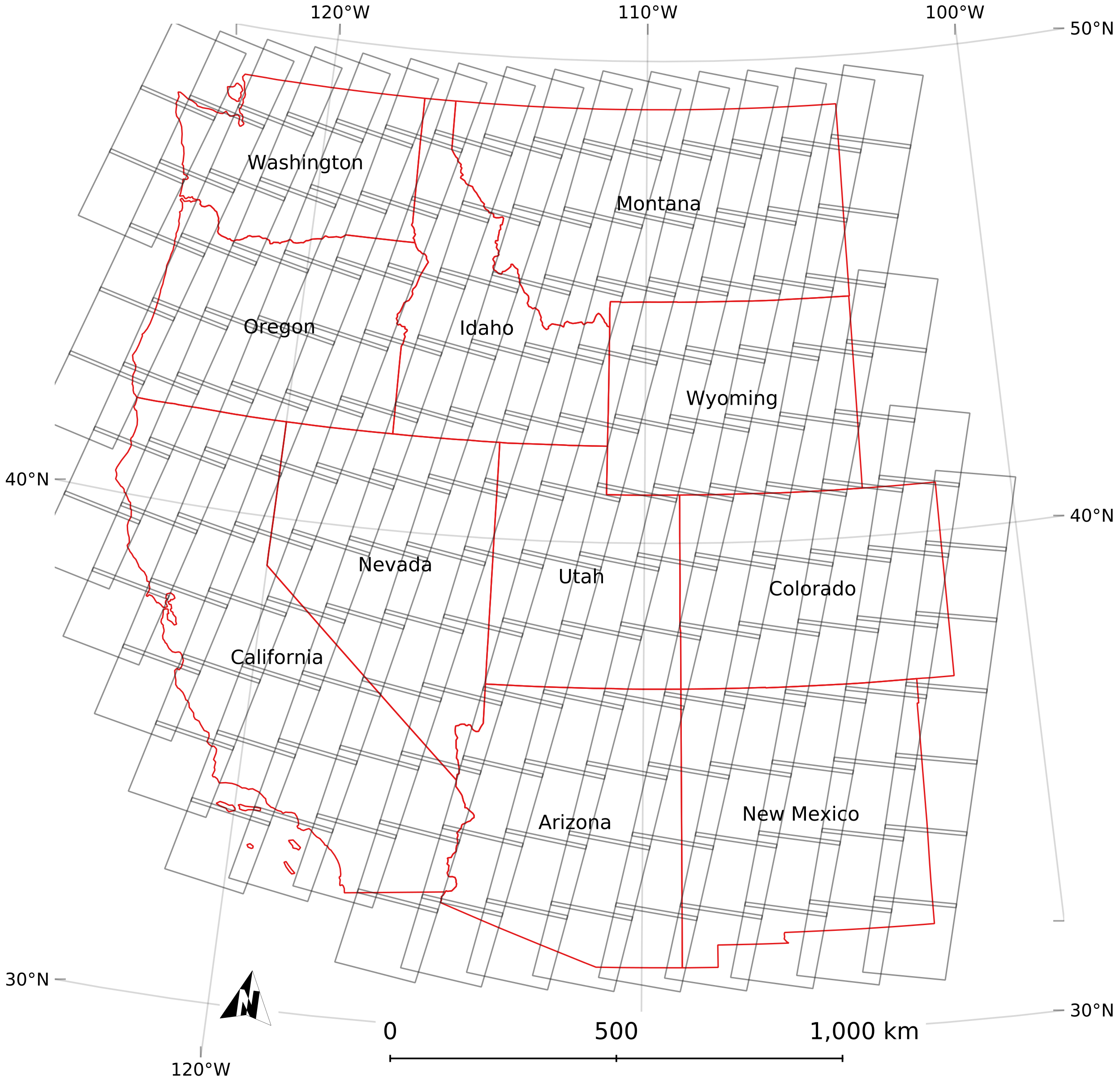
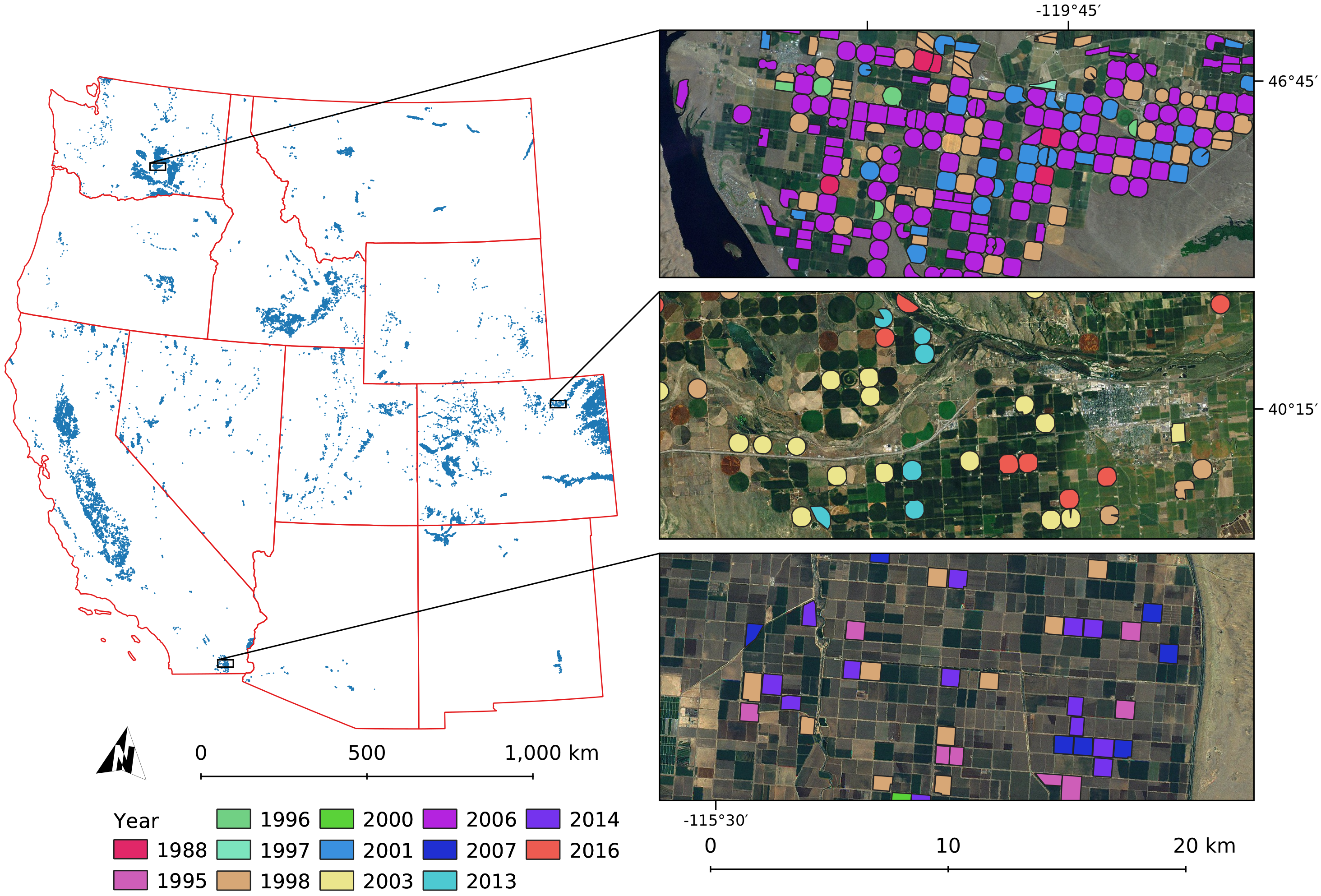
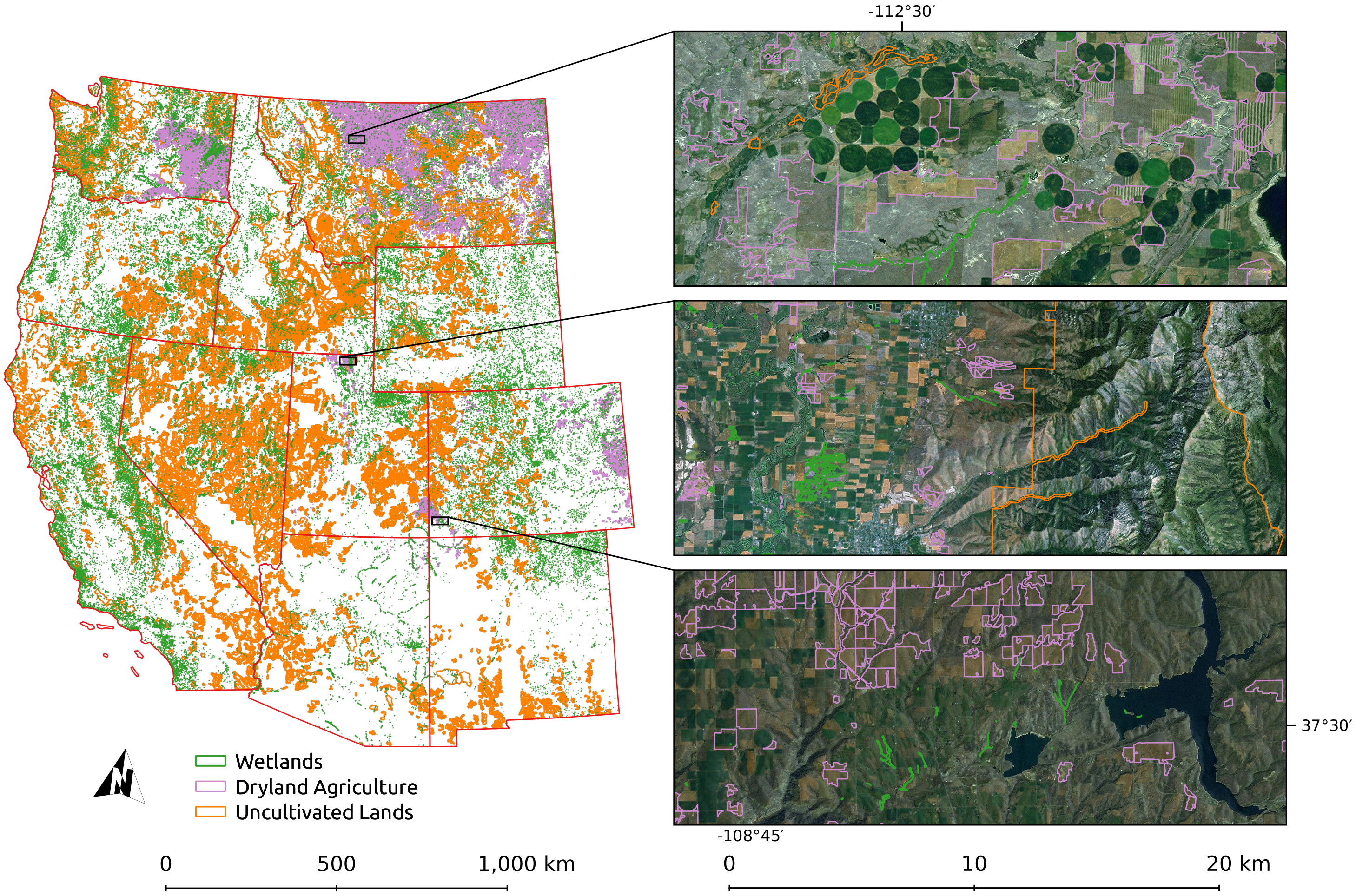
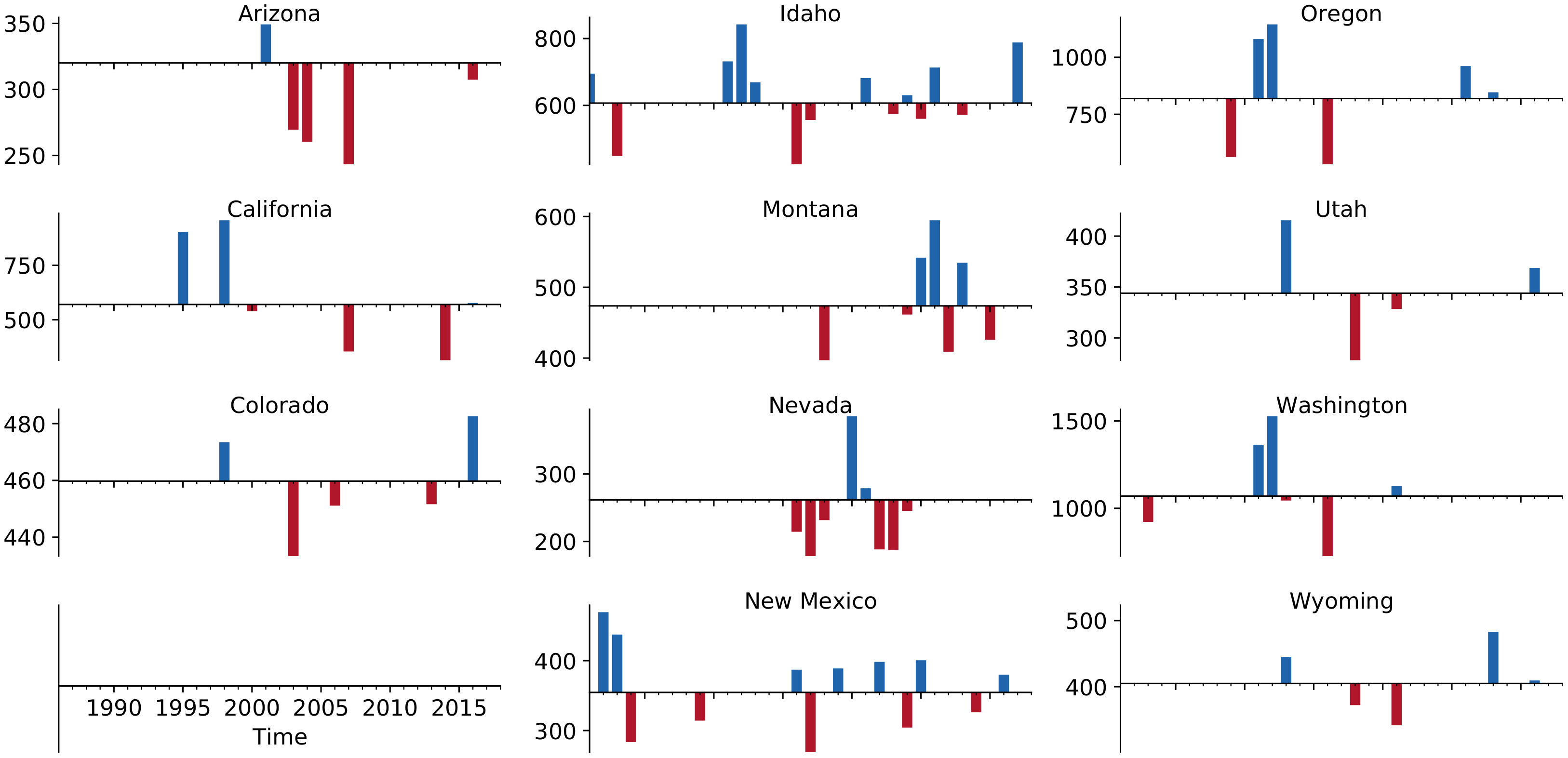
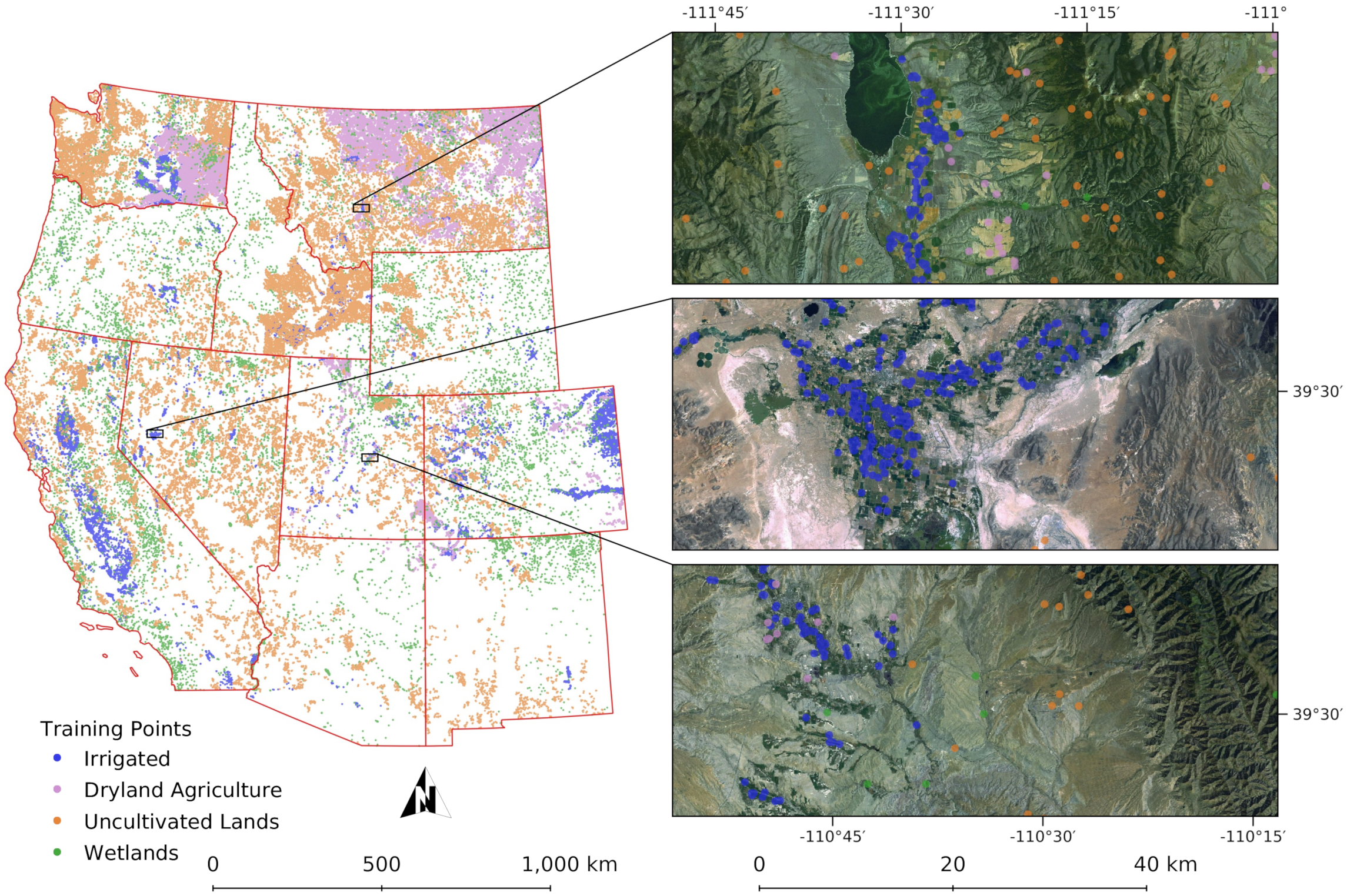
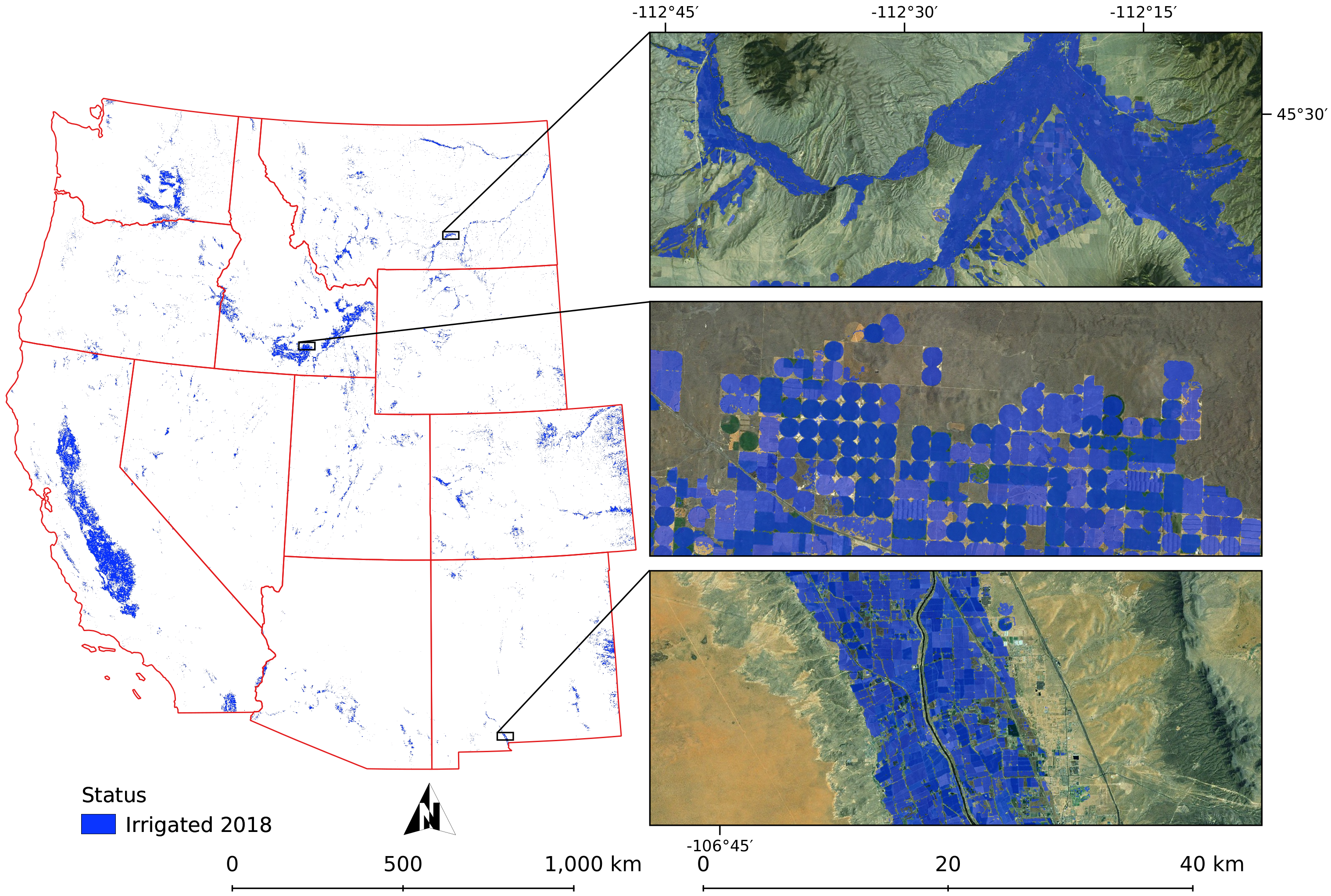
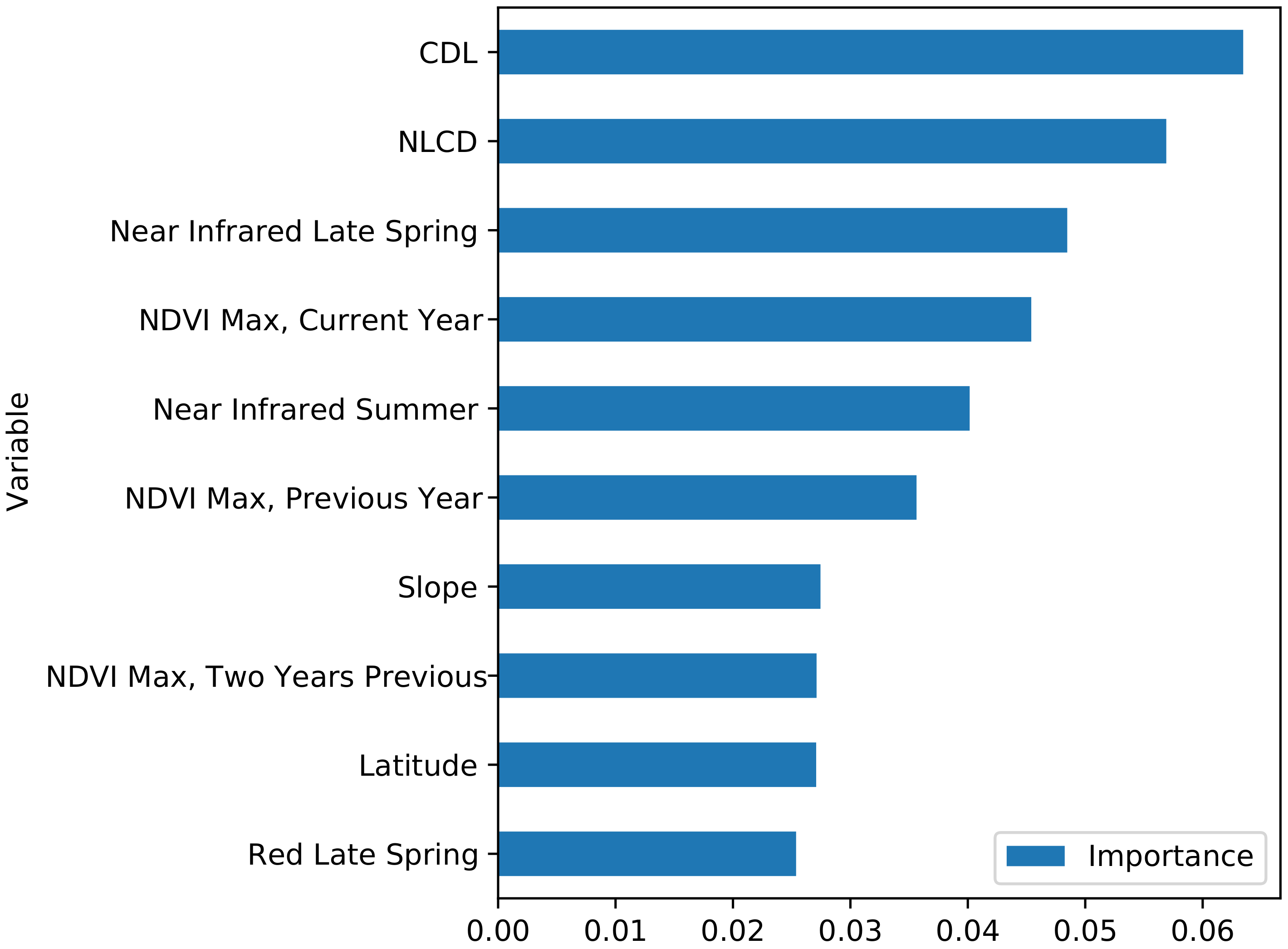
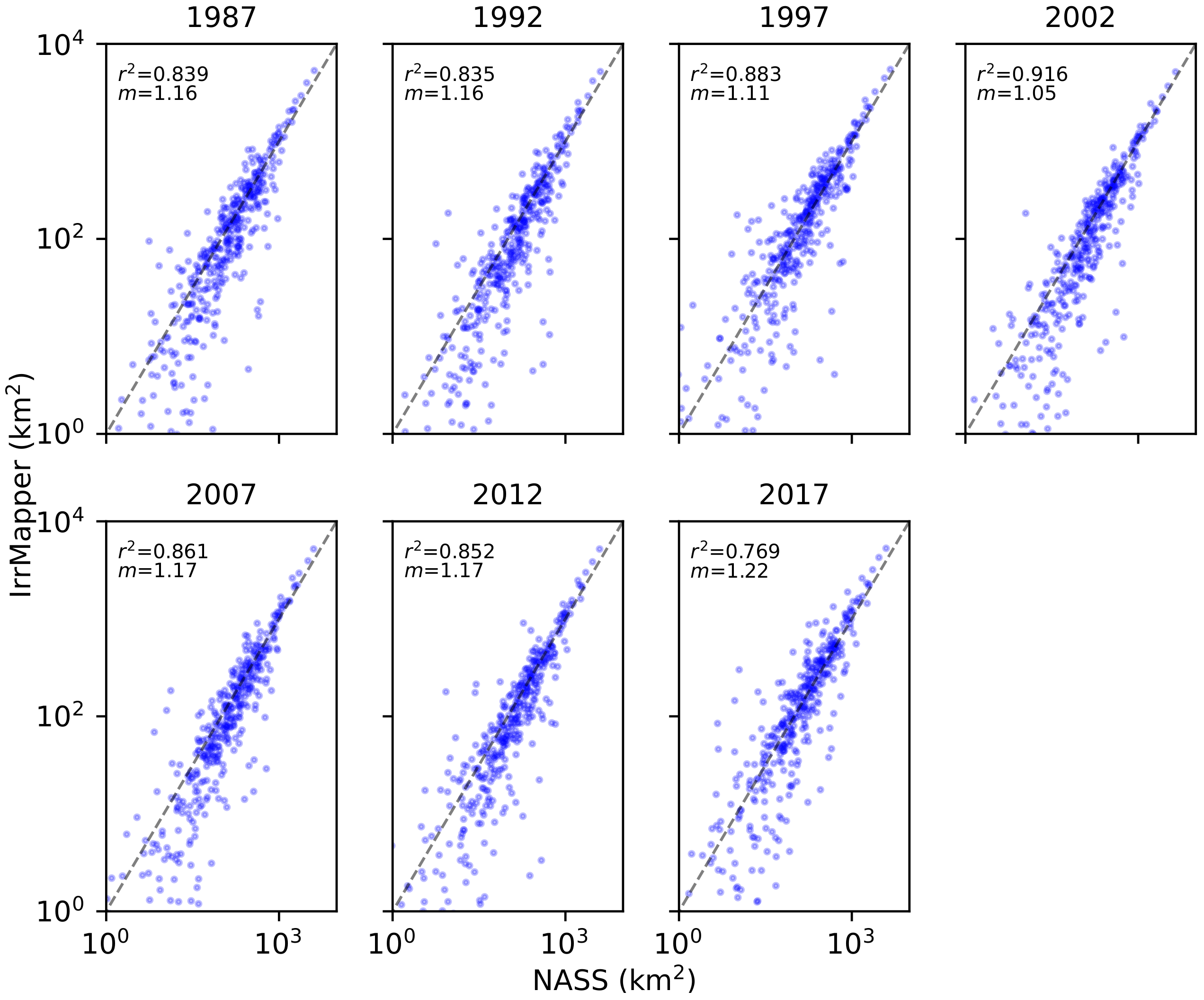
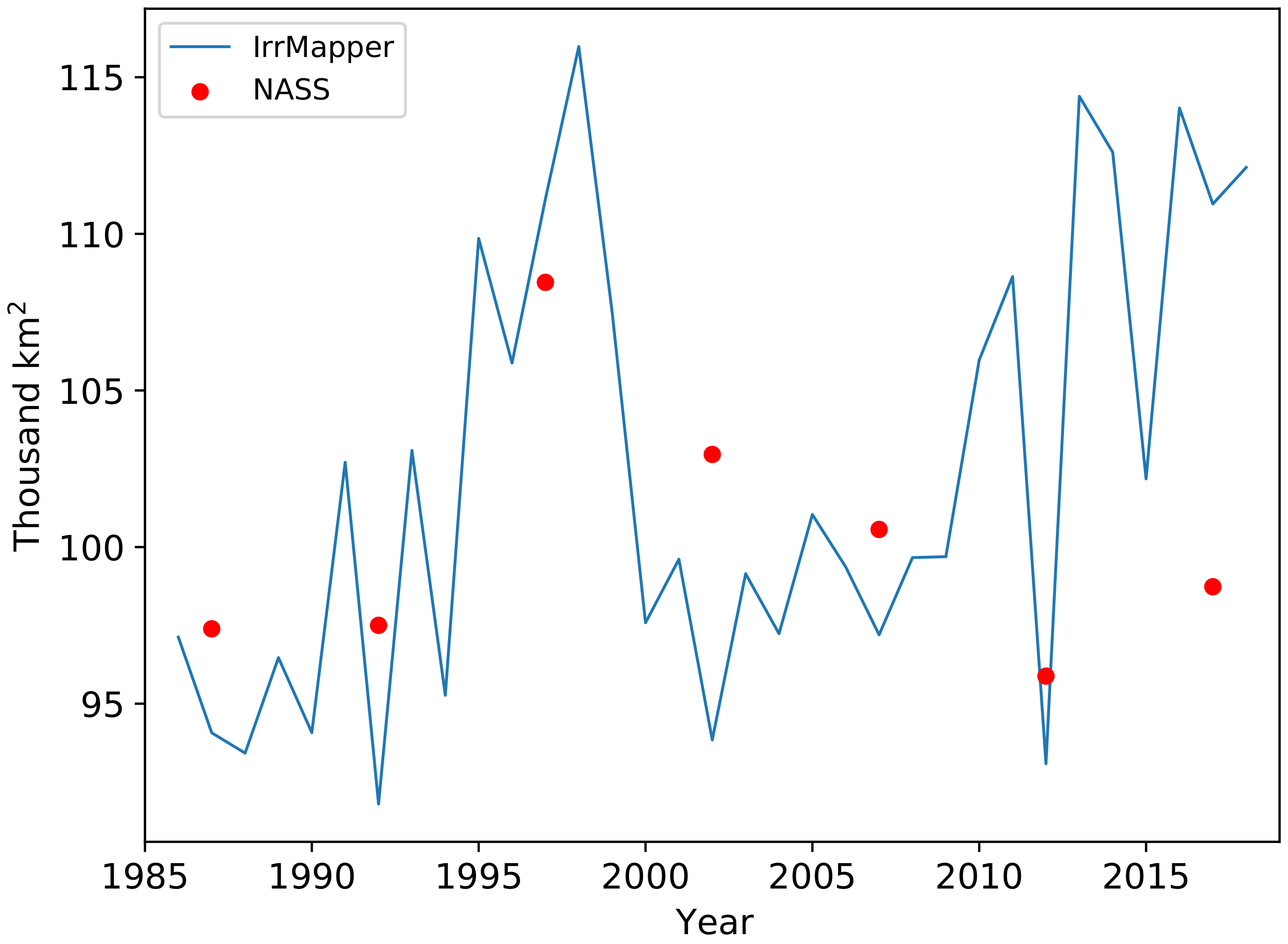
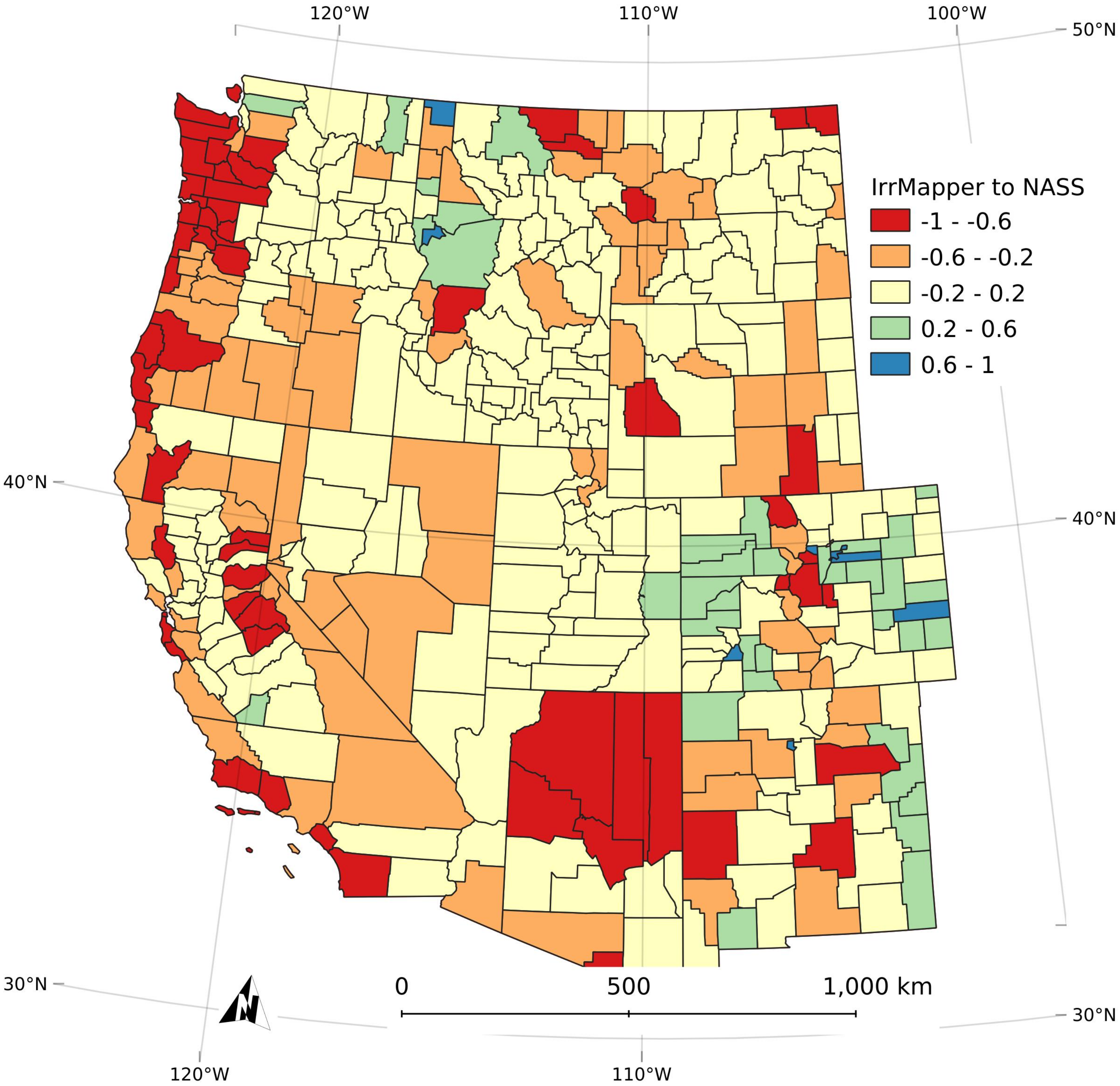
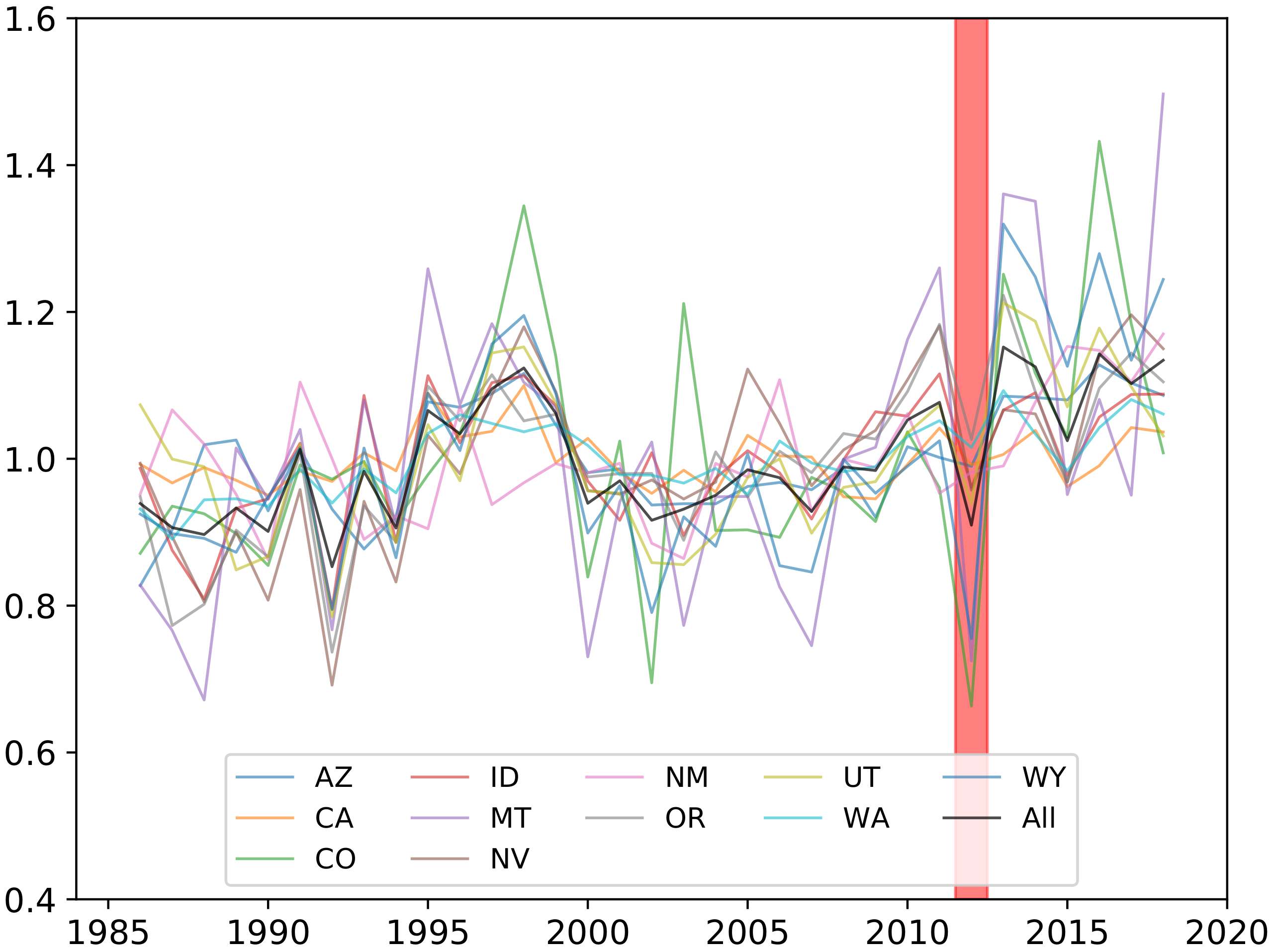
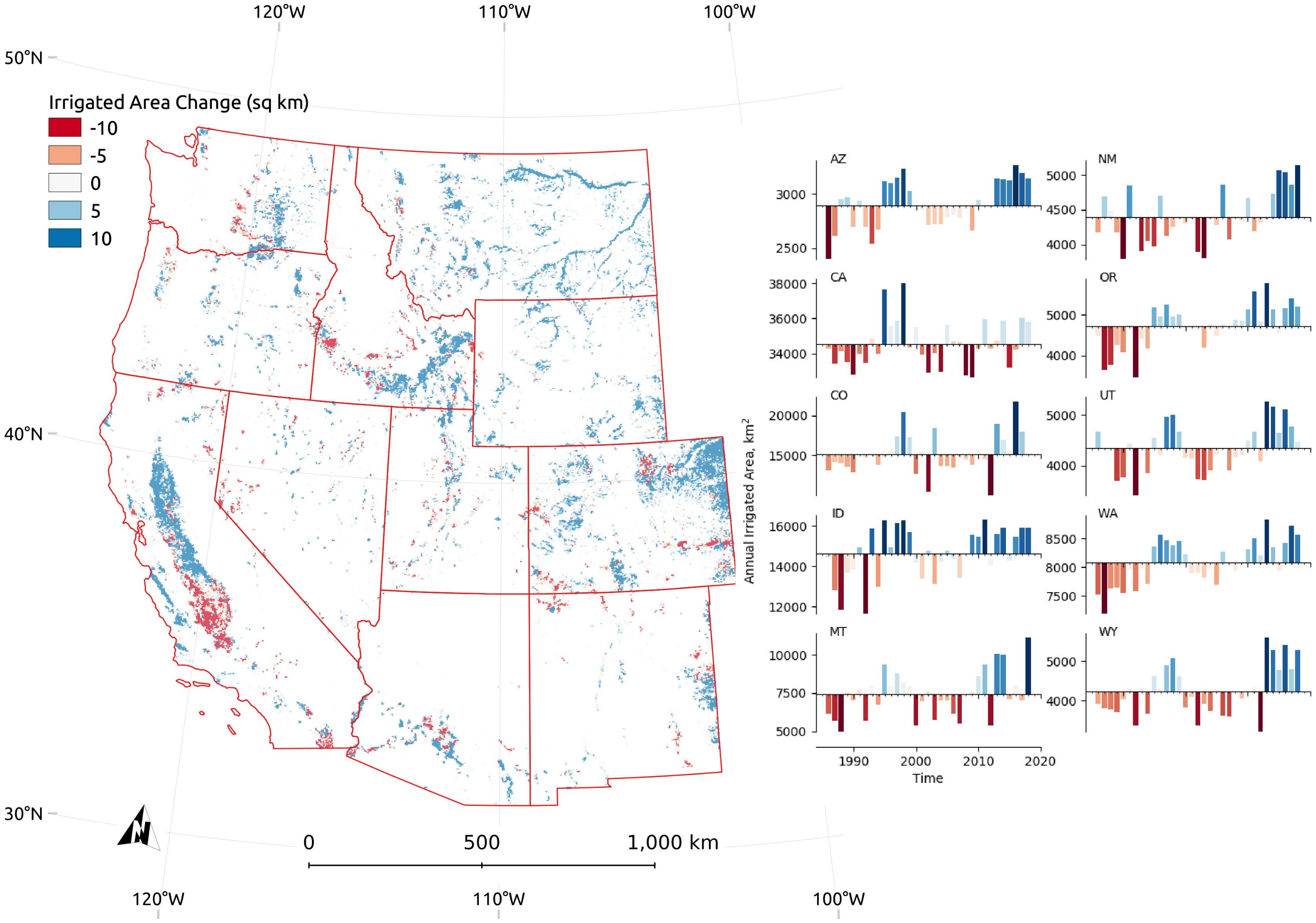
| State | Source | Irr. Inspected | Coverage | Irr. | Dry. | Uncult. a,b | Wet. c |
|---|---|---|---|---|---|---|---|
| AZ | USGS d | 2001, 2003, 2004, 2007, 2016 | Features | 133 | 1843 | 437 | 4711 |
| Hand-drawn | Area (km) | 49.949 | 49 | 29,301 | 289 | ||
| CA | CACASA e | 1995, 1998, 2000, 2007, 2014, 2016 | Features | 6022 | 0 | 5812 | 20,822 |
| DRI f | Area (km) | 3676 | 0 | 5876 | 472 | ||
| CO | CO DWR g | 1998, 2003, 2006, 2013, 2016 | Features | 23,919 | 3793 | 414 | 9012 |
| USGS d | Area (km) | 4009 | 7468 | 29,204 | 200 | ||
| CLU h | |||||||
| Hand-drawn | |||||||
| ID | ID DWR i | 1986, 1988, 1997, 1998, 2001, 2002, 2006, 2008 | Features | 4196 | 82 | 8168 | 5004 |
| CLU h | Area (km) | 2355 | 73 | 105,838 | 82 | ||
| Hand-drawn | |||||||
| MT | MT DNRC j | 2008, 2009, 2010, 2011, 2012, 2013 | Features | 4112 | 15,120 | 10,401 | 10,611 |
| Hand-drawn | Area (km) | 628 | 47,656 | 85,573 | 64 | ||
| NM | USGS d | 1987, 1988, 1989, 1994, 2001, 2002, 2004, 2009, 2010, 2014, 2016 | Features | 3563 | 615 | 455 | 6004 |
| NM WRRI k | Area (km) | 353 | 28 | 24,636 | 42 | ||
| Hand-drawn | |||||||
| NV | DRI e | 2001, 2002, 2003, 2005, 2006, 2007, 2008, 2009 | Features | 2346 | 0 | 1769 | 9496 |
| Area (km) | 518 | 0 | 122,591 | 442 | |||
| OR | OR DWR l | 1994, 1996, 1997, 2001, 2011, 2013 | Features | 1009 | 0 | 612 | 9923 |
| CLU h | Area (km) | 333 | 0 | 34,348 | 393 | ||
| Hand-drawn | |||||||
| UT | UT DWR m | 1998, 2003, 2006, 2013, 2016 | Features | 2323 | 5327 | 726 | 5399 |
| Area (km) | 518 | 1175 | 47,196 | 147 | |||
| WA | WSDA n | 1988, 1996, 1997, 1998, 2001, 2006 | Features | 4828 | 16,960 | 10,067 | 9764 |
| Area (km) | 1833 | 14,225 | 15,239 | 167 | |||
| WY | WY WDO o | 1998, 2003, 2006, 2013, 2016 | Features | 916 | 77 | 529 | 9553 |
| Hand-drawn | Area (km) | 387 | 21 | 38,331 | 139 |
| Predicted | |||||
|---|---|---|---|---|---|
| Irrigated | Dryland | Uncultivated | Wetland | ||
| Actual | Irrigated | 9893 | 24 | 15 | 68 |
| Dryland | 149 | 9660 | 68 | 123 | |
| Uncultivated | 76 | 131 | 9058 | 733 | |
| Wetland | 555 | 432 | 1304 | 7708 | |
| Predicted | |||
|---|---|---|---|
| Irrigated | Unirrigated | ||
| Actual | Irrigated | 183 | 2 |
| Unirrigated | 136 | 9679 | |
© 2020 by the authors. Licensee MDPI, Basel, Switzerland. This article is an open access article distributed under the terms and conditions of the Creative Commons Attribution (CC BY) license (http://creativecommons.org/licenses/by/4.0/).
Share and Cite
Ketchum, D.; Jencso, K.; Maneta, M.P.; Melton, F.; Jones, M.O.; Huntington, J. IrrMapper: A Machine Learning Approach for High Resolution Mapping of Irrigated Agriculture Across the Western U.S. Remote Sens. 2020, 12, 2328. https://doi.org/10.3390/rs12142328
Ketchum D, Jencso K, Maneta MP, Melton F, Jones MO, Huntington J. IrrMapper: A Machine Learning Approach for High Resolution Mapping of Irrigated Agriculture Across the Western U.S. Remote Sensing. 2020; 12(14):2328. https://doi.org/10.3390/rs12142328
Chicago/Turabian StyleKetchum, David, Kelsey Jencso, Marco P. Maneta, Forrest Melton, Matthew O. Jones, and Justin Huntington. 2020. "IrrMapper: A Machine Learning Approach for High Resolution Mapping of Irrigated Agriculture Across the Western U.S." Remote Sensing 12, no. 14: 2328. https://doi.org/10.3390/rs12142328
APA StyleKetchum, D., Jencso, K., Maneta, M. P., Melton, F., Jones, M. O., & Huntington, J. (2020). IrrMapper: A Machine Learning Approach for High Resolution Mapping of Irrigated Agriculture Across the Western U.S. Remote Sensing, 12(14), 2328. https://doi.org/10.3390/rs12142328





